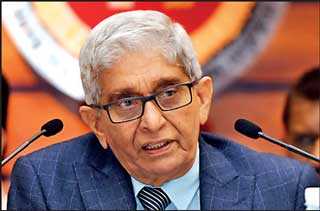Friday Nov 15, 2024
Friday Nov 15, 2024
Friday, 21 May 2021 00:28 - - {{hitsCtrl.values.hits}}
 |
| Central Bank Governor Prof. W. D. Lakshman
|
The Monetary Board yesterday kept policy rates unchanged, as mostly expected, to continue with its support for the recovery of the economy amidst a worsening COVID-19 pandemic.
The Board said it arrived at this decision after carefully considering the macroeconomic conditions and expected developments on the domestic and global fronts.
“In the context of the prevailing low inflation environment and well anchored inflation expectations, and the renewed challenges posed by the third wave of the COVID-19 pandemic, the Board remains committed to maintaining the current accommodative monetary policy stance to support the sustained revival of the economy,” a statement issued by the Central Bank said.
It emphasised the third wave of the COVID-19 pandemic has disrupted the ongoing recovery of economic activity.
“The Central Bank will continue to monitor domestic and global macroeconomic and financial market developments and stand ready to take proactive measures to help the economy to sustain the growth trajectory, while maintaining inflation in the targeted 4-6% range under the flexible inflation targeting framework,” it added.
The bank said the economy, which rebounded notably during the second half of 2020 and early 2021 as per available indicators, is experiencing renewed disruptions due to the emergence of the third wave of the COVID-19 pandemic and related preventive measures, including isolations.
While its adverse effects on economic activity are expected to be lesser than during the first two waves due to the selective nature of mobility restrictions and the ongoing vaccination drive, the third wave has once again highlighted the disruptive nature of the pandemic and the challenges faced in sustaining the economic recovery amidst the pandemic. It has also highlighted the need for continued fiscal and monetary support to place the recovery process on a firm footing.
The Central Bank also said the external sector remains resilient despite a multitude of challenges.
“The merchandise trade deficit widened in March, driven by a higher increase in expenditure on imports than the increase in earnings from exports,” it said.
The notable increase in workers’ remittances continued during the period from January to April, over the corresponding period of the previous year. “However, the recent surge in the global spread of COVID-19, could affect the recovery of the tourism industry, while posing renewed challenges to the external sector,” the bank added.
It also said the rupee depreciated by 6.6% against the dollar thus far in 2021, and the continuation of the existing restrictions on non-essential imports and selected foreign exchange outflows is expected to help ease the pressure on the domestic foreign exchange market.
Measures taken by the Government and the Central Bank helped secure foreign exchange inflows into the country, with additional standby arrangements to bolster confidence in the Sri Lankan economy. As of end-April, gross official reserves were estimated at $ 4.5 billion, equivalent to 3.2 months of imports. This does not include the bilateral currency swap facility with the People’s Bank of China (PBoC).
Central Bank also said prevailing historically low interest rates have resulted in an acceleration of private sector credit.
Reflecting the gradual transmission of the monetary policy easing measures adopted by the Central Bank thus far, market interest rates have displayed a broad-based decline to their historic low levels. The prevailing accommodative monetary policy stance and the high level of rupee liquidity maintained in the domestic market are aimed at supporting the economic recovery through the provision of affordable credit to productive sectors of the economy.
Accordingly, credit extended to the private sector increased notably during the first quarter of 2021, with increased credit disbursements to all key sectors of the economy.
The introduction of priority sector lending targets for banks on lending to the micro, small and medium scale enterprises (MSME) sector will continue to provide further support for promoting credit to the needy sectors of the economy.
Credit obtained by the public sector from the banking system continued to rise during the first quarter of 2021.
The bank said yields on Government securities also showed some increase, reflecting the impact of the increased financing requirement of the Government amidst the decline in revenue and the increase in expenditure, including pandemic related expenses. The expansion of domestic credit caused the growth of broad money (M2b) to remain elevated.
The monetary authority also expects inflation to remain within 4-6% range in the near to medium-term, while any pressures over the medium-term will be addressed with appropriate measures.
It said inflation remained subdued thus far in 2021, supported by well anchored inflation expectations and subdued aggregate demand conditions. While some inflationary pressures could emerge in the near term driven by supply-side disruptions due to the third wave of the pandemic as well as adverse weather conditions, inflation is expected to remain broadly within the desired target range of 4-6% during the remainder of the year.
Although the effects of the fiscal and monetary stimulus measures are expected to exert some upward pressure on inflation over the medium term with the envisaged improvements in aggregate demand conditions, such pressures will be mitigated through timely measures by the Central Bank, thereby ensuring the maintenance of inflation in mid-single digit levels in the medium term, while facilitating the sustained and high economic growth in the period ahead.
Following yesterday’s Monetary Board decision, the policy interest rates, i.e., Standing Deposit Facility Rate (SDFR) and the Standing Lending Facility Rate (SLFR) of the Central Bank, remain 4.50% and 5.50%, respectively.